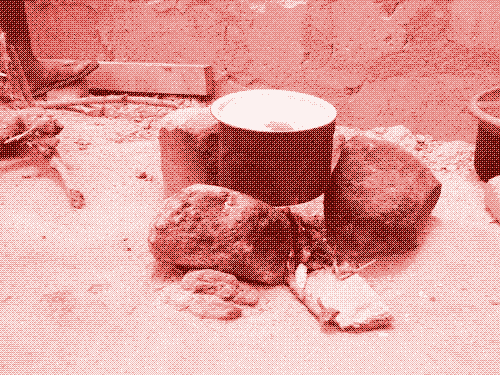
Despite technological advancements since the Industrial Revolution, cooking remains a spectacularly inefficient process. This holds true for poor and rich countries alike. While modern gas and electric cooking stoves might be more practical and produce less indoor pollution than the open fires and crude stoves used in developing countries, they are equally energy inefficient.
In fact, an electric cooking stove is only half as efficient as a well-tended open fire, while a gas hob is only half as effective as a biomass rocket stove. And even though indoor air pollution is less of an issue with modern cooking stoves, research indicates that pollution levels in western kitchens can be surprisingly high.
Three-stone Fire
Present-day cooking methods in poorer countries are quite well documented, as they are one of the main concerns of NGOs which promote appropriate technological development. An estimated 2.5 to 3 billion people still cook their food over open fires or in rudimentary cookstoves, and these numbers keep increasing due to population growth.
The most basic and widely used type of cooking device is the wood-fuelled “three-stone fire”, which is made by arranging three stones to make a stand for a cooking pot. Alongside the three-stone fire – which dates back to Neolithic times — many types of home-made cooking stoves can be found. They are powered by burning coal or biomass, be it wood, crop residues, dung or charcoal. 1
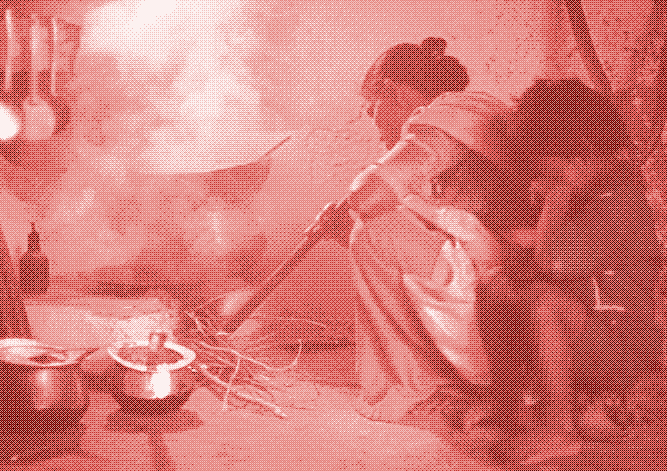
The main concern with the use of crude biomass cooking stoves is their destructive influence on human welfare and natural resources. When used indoors, biomass cooking stoves lead to severe health issues such as chronic lung diseases, acute respiratory infections, cataracts, blindness, and adverse effects on pregnancy. The main victims are women, who do most of the housework, and young children, who are often carried on the mother’s back while she is cooking.
Inefficient biomass stoves also force people (again, most often women) to spend much of their time collecting fuel. The environmental degradation caused by biomass stoves can be equally problematic. When wood is used as a primary fuel, inefficient cooking methods lead to deforestation, soil erosion, desertification and emissions of greenhouse gases. For coal-fuelled stoves, the main issue is indoor air pollution.
The Thermal Efficiency of a Three-stone Fire
At the heart of the problem lies the low thermal efficiency of traditional cooking methods. For three-stone fires, thermal efficiency is stated to be as low as 10 to 15%. 1 In other words: 85 to 90% of the energy content in the wood is lost as heat to the environment outside the cooking pot. Obviously, this low efficiency wastes natural resources, but it also boosts air pollution and greenhouse gas emissions because the relatively low temperature of the fire leads to incomplete combustion.
Well-constructed three-stone fires protected from wind and tended with care score between 20 and 30% thermal efficiency
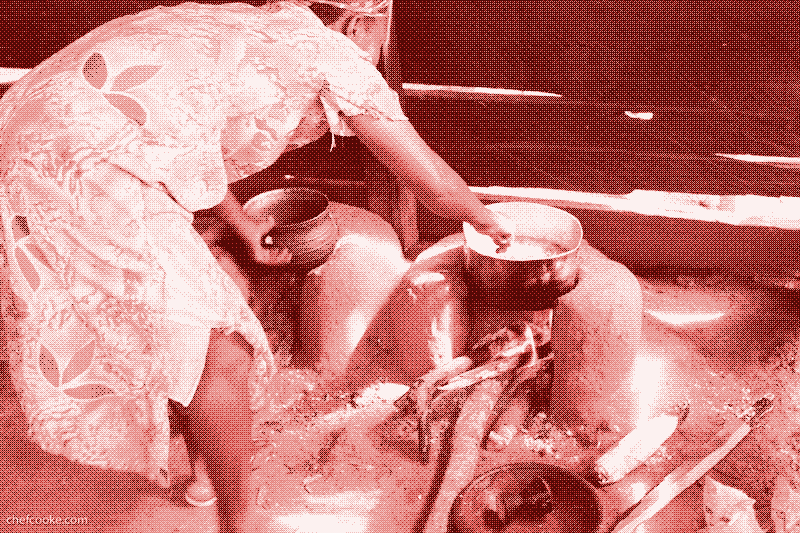
However, the issue is more complicated than it is usually presented. To begin with, the productivity and cleanliness of an open fire (and similar crude cooking stoves) greatly depends on the circumstances in which they are used and on the skills of the cook. In its test of 18 cooking stove designs from all over the world, the Partnership for Clean Indoor Air (PCIA) 2 concluded that:
“Well-constructed three-stone fires protected from wind and tended with care scored between 20 and 30% thermal efficiency. Open fires made with moister wood and operated with less attention to the wind can score as low as 5%. The operator and the conditions of use largely determine the effectiveness of operation. If the sticks of wood are burnt at the tips and pushed into the center as the wood is consumed, the fire can be hot and relatively clean burning.”
Due to the influence of environmental factors such as wind, an indoor three-stone fire is generally more efficient than one operated outside. However, outdoor open fires can also be made more efficient by placing them in a hole in the ground or by shielding them with the use of earthen walls, which also adds thermal mass. Furthermore, PCIA remarks that “it is important to recognize that the open hearth and resulting smoke often have considerable cultural and practical value in the home, including control of insects”.
The Thermal Efficiency of Improved Biomass Stoves
Especially since the 1970s and 1980s, many international NGO’s have tried to improve cooking traditions in poorer countries. This has resulted in a large number of so-called “improved cooking stoves”, which again vary in terms of design, performance and costs. Hundreds of variations exist. 1

Some of these designs are exclusively aimed at minimising air pollution at the cost of higher fuel consumption, while other designs achieve a higher efficiency but increase air pollution. 3 In this article, we will focus exclusively on cooking stoves that address both issues simultaneously. This is not to suggest that other designs can’t be preferable in certain circumstances. For example, because biomass cooking stoves do not present direct health problems when used outdoors, saving fuel would be the most important aim in that context.
Compared to a basic three-stone fire with 10-15% thermal efficiency, improved cooking stoves can easily halve the fuel requirements of the cooking process. This can be achieved by providing an insulated combustion chamber, improving the air supply, and other measures.
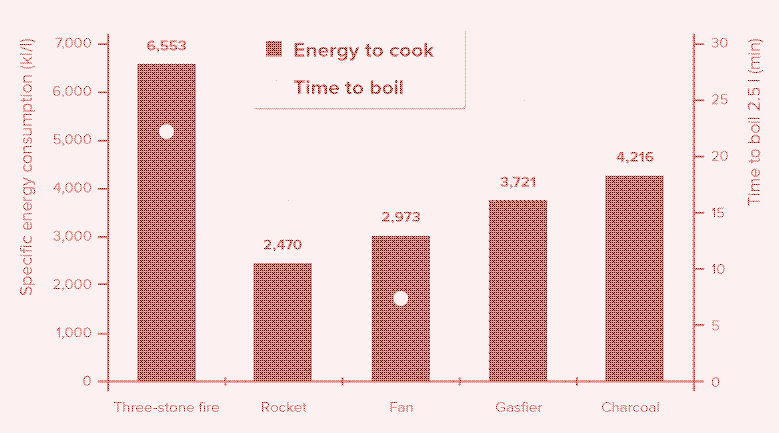
In a laboratory comparison of five major types of biomass cooking stoves, it was found that an improved rocket stove uses 2,470 kJ to boil one litre of water and then simmer it for 30 minutes, while a basic three-stone fire requires 6,553 kJ to fulfill the same task (see the dark blue bars in the graphic above). 4 The rocket stove thus uses 60% less fuel than the three-stone fire. Furthermore, the rocket stove boils 2.5 litres of water more than 5 minutes faster (see the light blue points in the graphic above).
A rocket stove can double the thermal efficiency of a well-tended open fire
The values are the average of three tests and measure specific energy consumption instead of thermal efficiency. Both test methods have their shortcomings — measuring the efficiency of cooking is surprisingly complex — so by applying both methods the accuracy of an experiment increases. 5 This was done by the Partnership for Clean Indoor Air, which compared the thermal efficiency and specific energy consumption of 18 cookstove designs, including a well tended open fire with a thermal efficiency of 20-30%. 3
In this study, one of the best performing improved biomass stoves — a 20 liter can rocket stove (image below) — convincingly beats the efficiency of the well-tended open fire. It requires 733 grams of wood (12,579 kJ) to bring five litres of water to boil and simmer for 45 minutes, only 65% of the 1,112 grams of wood (19,496 kJ) required by the well-tended open fire. The thermal efficiency of the rocket stove varies between 23 and 54%. 6
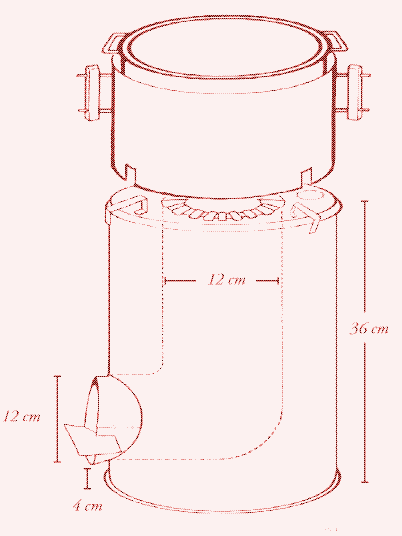
The rocket stove also lowers air pollution: the emissions are only 26% of the carbon monoxide (CO) and 60% of the particulate matter (PM) produced by the well-tended open fire. Lastly, it shortens cooking time to 22 minutes for five litres of water, compared to 27 minutes for the open fire.
The top performing biomass stove in the test is a wood gas stove, with slightly more than one-third the wood consumption (459 grams of wood or 9,434 kJ) and 15-20% of the pollution levels of the three-stone fire. It has a thermal efficiency of 44-46%. However, it requires an electric fan to improve combustion efficiency, while all others are natural-draft stoves.
Cooking in Wealthy Households
There is great irony in the fact that the improved biomass stoves mentioned above are much more efficient than modern cooking stoves used in the western world and in wealthier households of developing nations. In fact, most modern cooking stoves have a thermal efficiency that is on par with that of a three-stone fire.
The western world switched from open fires to closed cookstoves from the eighteenth century. Initially, these “kitchen stoves” were used for both heating and cooking, and were powered by coal, charcoal or biomass. When central heating systems were introduced in the early twentieth century, the kitchen stove was replaced by a stand-alone cooking appliance, powered by gas or electricity.
Improved biomass stoves have double or triple the thermal efficiency of modern electric or gas cooking stoves
Conventional electric hobs use attached iron plates as their heating units, while more sophisticated models use infrared, halogen or induction units, which are positioned below glass ceramics. Of these, only induction-based cooking plates are more efficient than conventional electric hobs. The others mainly offer increased convenience, such as greater ease when cleaning. Most gas cooking stoves place burners on top of a stainless steel or ceramic surface, while others place them on top or beneath a glass ceramic surface. Again, the latter offers increased convenience, but no significant efficiency benefit. 7
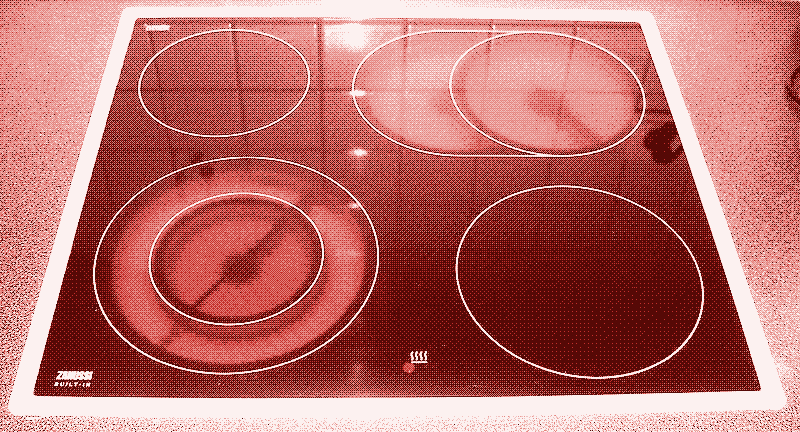
Research into the efficiency of modern cooking stoves is rather limited. According to a study by the Dutch research institute VHK, a traditional electric cooktop (with vitro-ceramic plate) has a thermal efficiency of 13%, while that of an electric induction cooker is 15%. A microwave obtains 19% thermal efficiency. Only a classical gas cooking stove (23%) reaches the thermal efficiency of a well-tended three-stone fire. 7
While the study is aimed primarily at the preparation of hot drinks, it is the most complete study available and its results are applicable to cooking food with only a few small caveats. 8
Now, if we compare the thermal efficiencies from modern cooking stoves with those from stoves used in poorer households, we see that the improved biomass stoves in developing countries beat our “high-tech” cooking technology with a factor of two to three (graphic below). Gas or electric ovens are not included in this comparison, but their efficiency is even lower than gas or electric hobs because water is a much better conductor of heat than air.
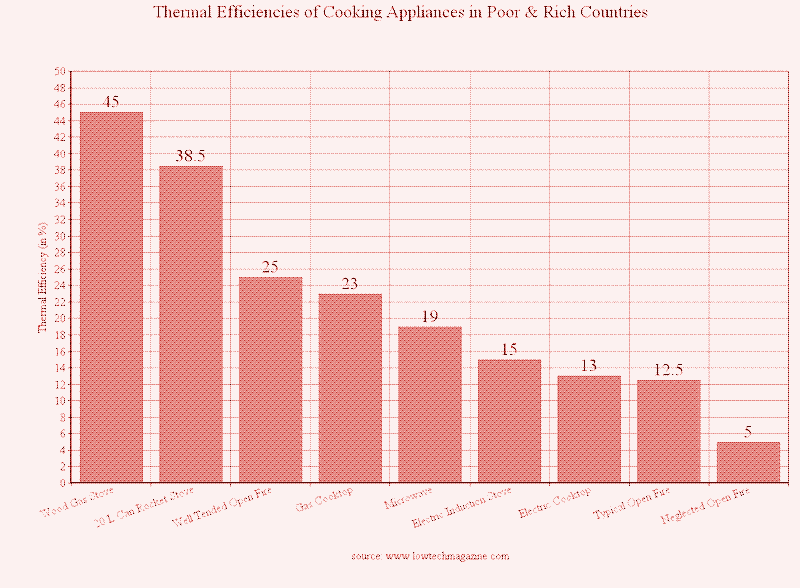
The low efficiency of modern cooking devices may surprise people, as these are not the figures that are usually presented in sales brochures or consumer reports. For example, the Californian Consumer Energy Center gives an efficiency level of 90% for an electric induction cooker, 65% for a standard electric range, and 55% for a gas burner. 9
Power Conversion Losses
The main discrepancy with these figures is caused when one doesn’t take into account that electricity first needs to be produced in power plants which sometimes convert less than a third of the primary energy into electricity 10 This is not an issue with gas or biomass stoves, where a primary fuel is directly converted into heat for cooking. 11 But it does have a destructive effect on the thermal efficiency of any electric cooking device, be it an electric hob or a microwave. In the graphic below, power conversion losses are indicated by the dark blue bars.
The VHK study assumes an electric grid efficiency of 40%. This figure takes into account power generation and distribution losses, as well as fuel extraction and a projected saving on these issues over an average product life of 10-15 years. 7 It should be noted that this percentage corresponds to a global average, including the use of renewables and atomic energy. Depending on the country, grid efficiency can be higher or lower. 12
![Boiling water preparation energy impact (kWh primary energy for 1,000 litre useful boiled water per year) for different cooking devices. Dark blue: power generation loss. Light blue: heat loss. Red: theoretical minimum. Pink: production, distribution, end-of-life. Pink: extra boiling time. Purple: standby. Green: over-filling. Source: [^8]](https://solar.lowtechmagazine.com/2014/06/well-tended-fires-outperform-modern-cooking-stoves/images/dithers/thermal-efficiency-cooking-stoves_dithered.png)
If we only look at the different types of thermal power plants, we find that the thermal efficiency for a traditional coal plant (81% of all coal-based power plants in use) is only 25 to 37%, while that of a common direct-combustion biomass power plant is only 20%. 12
At world level, the average energy efficiency of thermal power plants is 36%. 12 These percentages should be reduced with electric transmission and distribution losses, which are on average 6% in Europe, 7% in the USA, and 9% on a world level. 12
This means that if your electric stove is operated by electricity from a biomass power plant — a fast growing “green” trend nowadays — the power conversion efficiency is three to four times lower (11-14%) than the authors of the study assume, and thermal efficiency drops to about 5%. This is similar to the thermal efficiency of a neglected open fire, and one-tenth the thermal efficiency of a rocket stove. Likewise, a cookstove which uses coal or gas directly to heat food is much more energy efficient than a cookstove that runs on electricity produced by a coal or gas power plant.
Essentially, any electric cooking device is an insult to the science of thermodynamics
Evidently, there is something wrong with the western approach to sustainability. Converting heat into electricity which is then converted back into heat, at 20-40% efficiency, is similar to building a Rube Goldberg machine; it’s a needlessly complex operation compared to simply converting the primary fuel into heat to boil water. Essentially, any electric cooking device is an insult to the science of thermodynamics.
Heat Transfer Loss
A second problem is that the high efficiency figures given in sales brochures and consumer reports underestimate the heat loss that occurs during the heat transfer from cooking stove to cooking pot (shown by the light blue bars in the graphic above). This heat loss is present with all cooking stoves, but is especially high in the case of gas hobs. In the graphic above, the red bar concerns the minimum energy that it takes to boil 1,000 litres of water, assuming that there is no energy loss during the heat transfer between the cooking stove and the water. This value is 105 kWh/yr for a starting cold water temperature of 10 degrees celsius.
Energy losses appear because of three reasons. Firstly, some heat from the cooking fire escapes before it can reach the cooking vessel. Secondly, some heat from the cooking fire is used to heat up the cooking pot, which constantly loses heat to the environment. Lastly, heat is wasted because some of the boiling water escapes through evaporation. While the red bar is logically the same for every cooking device, the light blue bar showing the additional energy required to compensate for heat transfer loss varies from 57 kWh/yr for an electric induction stove to 255 kWh/yr for a gas hob.
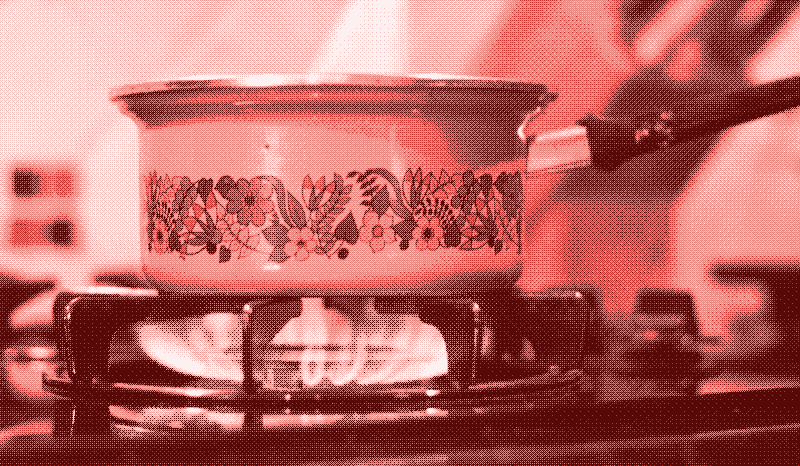
Heat transfer loss is not fully accounted for in most testing standards for cooking appliances. For example, the US standard uses a test by which the heat transfer efficiency of a cooking top is established from heating up aluminum cylinders of certain dimensions, not pots of water. 1314 This avoids the complex phase change from liquid to vapour and is thus better reproducible.
Heat transfer loss is not fully accounted for in most testing standards for cooking appliances
However, as all the heat of the cylinder is counted as useful, it ignores that in real life situations some energy — notably the energy to heat up the pot or kettle itself — is wasted. Only taking into account the energy loss in heating the pot itself, energy efficiency decreases with about 10% of the figures given by standard tests, concludes VHK. 7 Furthermore, the US test is modeled after the process of boiling food on all burners or hot plates simultaneously, which is not always the case. Heat transfer losses are larger when only one or two pots are on the fire.
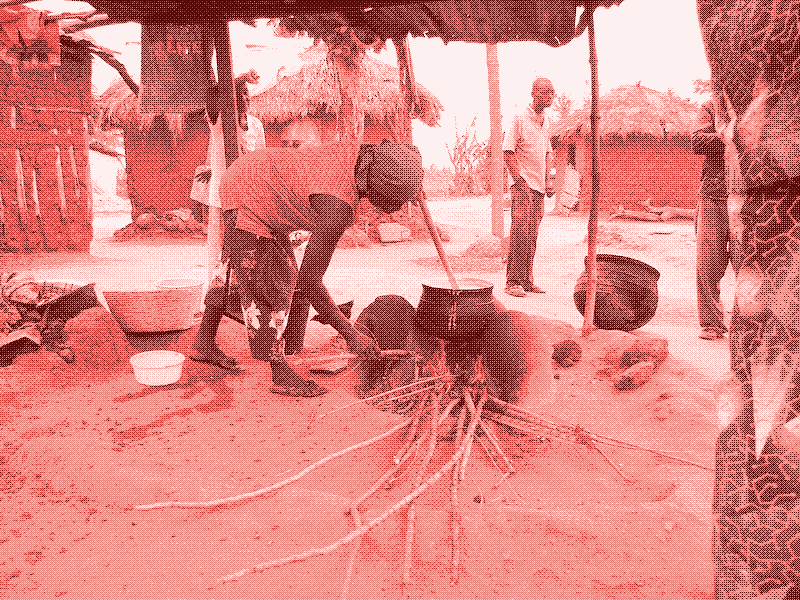
Apart from power conversion losses and heat transfer losses, the remainder of the energy losses are due to production, distribution and disposal of cooking devices (embodied energy), standby losses (which are only relevant for microwaves, induction stoves and sophisticated gas stoves), and cooking habits. These factors have a relatively small influence.
Of all the energy losses involved in modern cooking appliances, only heat transfer loss applies to cooking devices in poorer households. There are no power conversion losses, fuel is mostly gathered by hand, there are no standby losses, and embodied energy is negligible as most devices are home-made.
Indoor Air Pollution in Rich vs. Poor Households
While the thermal efficiency of modern cooking devices is clearly inferior to that of a well-tended three-stone fire or rocket stove, they do have an advantage when it comes to indoor air pollution. However, this is not a black-and-white issue either. Air pollution levels depend on what you’re cooking, how skillful you are, and which technology you use.
In the worst case scenario, pollution levels in modern kitchens can be similar to those of a well-tended three-stone fire indoors. This is not to say that the problem of indoor pollution in poor households is overstated, but rather that cooking in modern kitchens is not always as clean as we assume it to be.
Pollution levels in modern kitchens can be similar to those of a well tended three-stone fire inside the house
Particulate matter (PM) is considered as the single best indicator of potential harm in air quality. 3 In poor households where indoor cooking happens with crude stoves or open fires, PM-levels vary from 200 to 5,000 ug/m3 over a 24-hour period, and from 300 to 20,000 ug/m3 during the actual use of stoves. 1516 The Partnership for Clean Indoor Air measured PM emissions for a well tended three-stone fire, which resulted in values of between 281 and 2,004 ug/m3 while cooking. 3
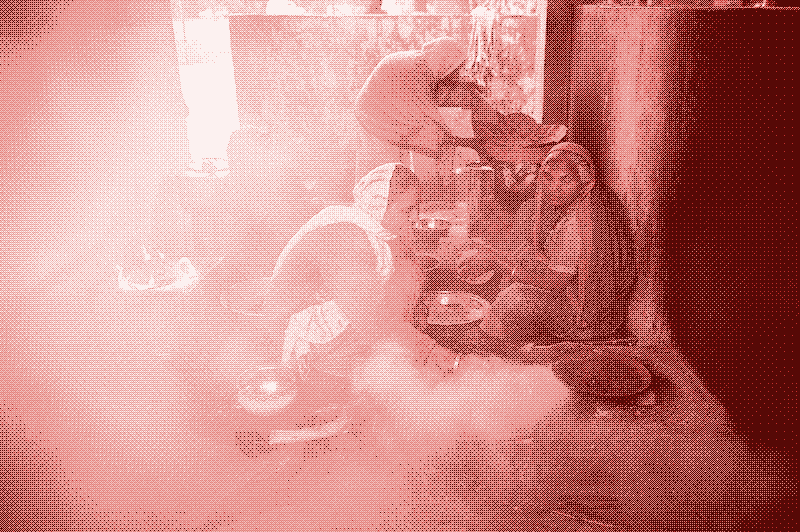
Similar research undertaken in a kitchen equipped with modern technology found PM concentrations in the kitchen, living room and bedroom from below the detection limit to 3,880 ug/m3 during a variety of 32 different cooking tests with gas and electric ranges. 17 The medium and average concentrations of PM during the 32 cooking tests exceeded ambient air quality standards (which are 150 g/m3 for PM10 and 65 ug/m3 for PM2.5). These values come close to the best-case scenarios in poor households.
Importantly, cooking pollutants are not caused by the burning of gas or fuel alone, but also in the cooking process itself. PM2.5 concentrations were over 1,000 ug/m3 during stovetop stir-frying, baking lasagna in the gas oven, and frying tortillas in oil on the range top burner. The authors conclude that:
“Very high levels of several pollutants were measured in indoor air during different types of cooking activities. The levels measured for some cooking activities exceeded health-based standards and guidelines, and could pose a risk to home occupants, especially susceptible groups of the population such as young children and the elderly.”
Unfortunately, gas stoves — which have the highest thermal efficiency of all modern cooking stoves — produce the most air pollution in modern kitchens. 17 The average indoor PM emissions for gas stoves can amount to 25% of those of biomass cooking stoves. 16 A 2014 study estimates that 60 percent of homes in California that cook at least once a week with a gas stove can reach pollutant levels of CO, NO2 and formaldehyde that would be illegal if found outdoors. 18 The authors state that:
“If these were conditions that were outdoors the EPA (Environmental Protection Agency) would be cracking down. But since it’s in people’s homes, there’s no regulation requiring anyone to fix it. Reducing people’s exposure to pollutants from gas stoves should be a public health priority.”
Air Pollution and Greenhouse Gas Emissions
Obviously, indoor cooking with an electric stove is the healthiest option, albeit not totally free from producing indoor air pollution. However, electric stoves are only “clean” because they emit most of their pollution elsewhere — at the smokestacks of the power plant. Any biomass stove design with a chimney basically achieves the same. If a chimney is added to an indoor biomass stove, indoor air pollution drops to almost zero. 3
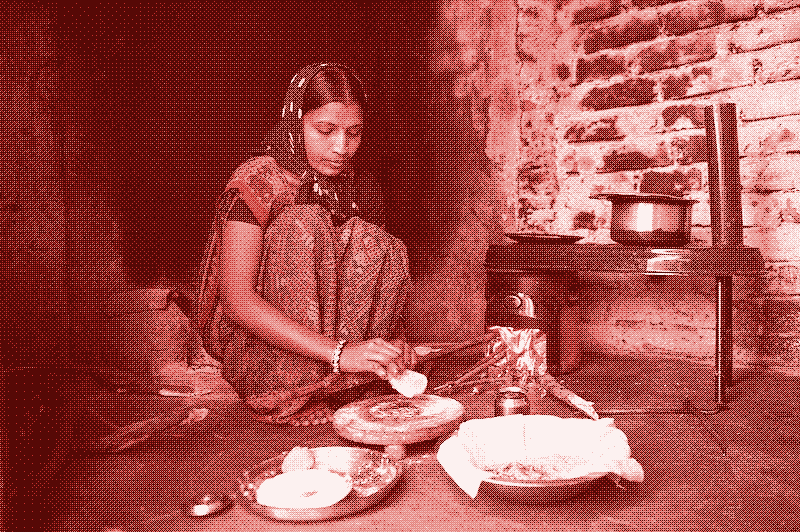
And while the burning of coal or gas emits less air pollution and greenhouse gases than the burning of biomass per unit of energy produced 19 you have to burn more fuel in order to make up for the power conversion losses. Especially if your electric stove runs on electricity from a biomass power plant, then air pollution and greenhouse gas emissions are much higher than in the case of a biomass stove.
If electricity is produced by biomass, an electric cooking stove produces much more air pollution and greenhouse gases than a biomass stove
On the other hand, if we consider biomass to be climate neutral over time because the harvested forest gets a chance to grow back, then a biomass stove beats all other cooking methods when it comes to greenhouse gas emissions. The same goes for the cooking stove powered by electricity from biomass, although it would produce considerably more air pollution than the biomass stove, and require a much larger area of sustainably managed forest.
What’s the solution?
When the German Wuppertal Institute investigated the potential for improved energy efficiency of cooking stoves on a global scale, they concluded that energy use could be halved. 20 Although it’s remarkable how the proposed solutions for this energy inefficiency differ for poor and rich countries. In the developing world, the focus is mainly on designing more efficient biomass stoves that produce fewer pollutants. While achieved savings as a result of switching to biogas would be larger, its investment would be 30 times higher compared to the distribution of improved wood cooking stoves. 20
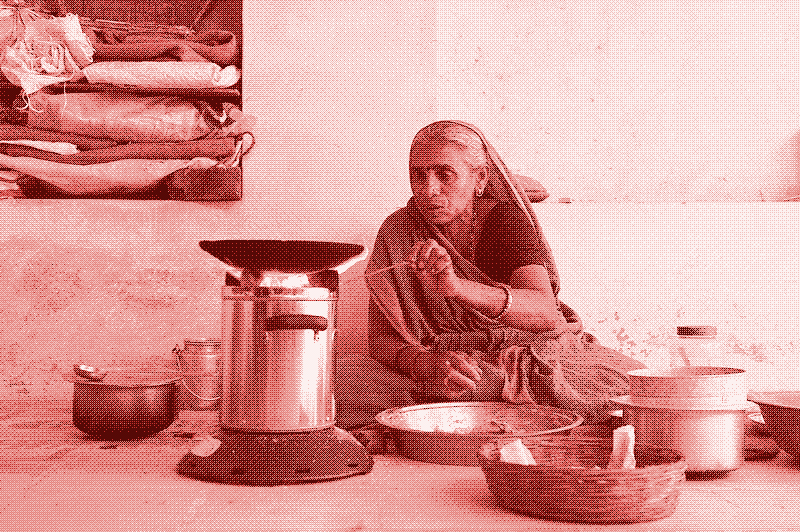
For the developed world, the Wuppertal Institute focuses on a much more costly measure: extending the use of the most efficient types of “western” stoves, such as the electric induction hob. However, as we have seen, these stoves are far less efficient than the improved biomass stoves, and they are also more expensive. The authors infer that, compared to developing countries, energy saving potentials with modern cooking stoves are far smaller and less cost-efficient. But as is apparent from the inefficiencies of western cooking technology, the energy savings potential is, in reality, larger.
One possibility for the West to improve the sustainability of its cooking stoves, not mentioned by the Wuppertal Institute, is to generate electricity by wind, solar or water energy. If electricity is generated by renewable energy, electric hobs and microwaves suddenly beat all other cooking stoves when it comes to efficiency, air pollution and greenhouse gas emissions. That being said, using renewable energy to produce electricity to create heat for cooking remains a needlessly complex and costly approach to make cooking more sustainable.
There are some obvious but often overlooked solutions that would make cooking close to 100% sustainable in rich and poor countries alike. See our follow-up article: “If we insulate our houses, why not our cooking pots?”.
Reactions
To make a comment, please send an e-mail to solar (at) lowtechmagazine (dot) com. Your e-mail address is not used for other purposes, and will be deleted after the comment is published. If you don’t want your real name to be published, sign the e-mail with the name you want to appear.
Reactions
Bart
Which is why this was invented: The Bio-Lite Home Stove - supremely efficient, burns clean, burns it all, and produces electricity. http://www.biolitestove.com/homestove/
max
Good article, but one aspect is missing. You could archive higher efficiency in cooking if you would use warm water from a solar water heater. If you want to boil photatos and would start with water that is at 70°C you would save a tremendous amount of energy.
Malcolm Gribble (Soluciones Apropiadas)
Good article. % efficiency isn’t always proportional to fuel savings however. In Guatemala where we work, food is prepared by boiling and also using a griddle and therefore a water boiling test is not appropriate. Another extremely important factor is adoption rates, usability, cultural acceptance, performance, size and durability all affect this. Designing stoves with local end users helps to produce more culturally acceptible products that a one size fits all stove from a factory in china won’t achieve.
pond
Another choice would be the solar oven. It cooks only when there is enough sunlight to raise the heat sufficiently, but as a low-cost addition to whatever burning stove is at hand, can reduce both pollution and increase efficiency.
Alfonso
@Bart:
Bio-Lite is pretty neat, but it seems like for home use, you’d be better off using hand-made bellows, so you don’t need batteries, especially lithium-ion batteries, to start the draft. I can understand that people might think pumping bellows is tedious or undignified, but still, it’s more resilient. Like many tedious, undignified things.
drs
I didn’t think biomass electricity was going to be significant compared to solar/wind. But if we are going to compare biomass electricity for home stoves to biomass fueled home stoves, for a full comparison you’d also have to consider the costs of distributing the biomass to the home, compared to delivering electricity. Especially when the energy for hot water tanks is considered, that could get significant, though I’d guess not enough to tip the energy efficiency scale; might well tip the cost scale, given costs of labor and storage.
People also care about convenience, of course: a gas, microwave, or electric stove is instant (or nearly so for resistance-based electric) and fairly brain dead to use; extrapolating from charcoal grill operation and your own text, a traditional oven would take more time and skill.
Matthias
Interesting article just a few points.
Electricity as well as Gas and fluid fuel can be easily controlled and switched on and off at will. That is nit so easy with solid fuel
Sometimes we only want to cook a cup of water or milk, in this case the microwave was most efficient as all other means of cooking need a too large container which is also heated. The smaller the quantity we want to cook the larger is the proportion of the container.
Usually cook fast is more efficient as the losses are in a shorter time. If we use to less power we will never get boiling water even we use a higher amount of energy.
The energy and time used to clean the pots etc is not considered. It is much higher with solid fuel.
If we actually cook food there are many ways for prepartion. A potato can be boiled, steamed, baked, fried, deep fried. It also matters how the potato is cut prior to cooking.
Many cuisines optimized the use of energy as a necessity. For example chinese cuisine. Everything is chopped to small pieces that it can be fried in a very short time in a wok. So high energy output but fast burning fuel can be used.
Gidon Gerber
I was just about to do some efficiency measurements at home, when I remembered that Tom Murphy had already done them for his fabulous “Do the Math” blog. His results are roughly consistent with the Quooker study [8].
http://physics.ucsd.edu/do-the-math/2012/05/burning-desire-for-efficiency/
A.J.
You treated several aspects of the issue in some detail. No real consideration of labor time – opportunity cost of providing your own solid fuel. Not usually pleasant or uplifting work. treating all particulate “pollution” the same, when particulate from cooking food are a whole different physiological effect than particulates from toxic fuels. So many more issues, positive and negative. Better to focus strongly on biogas, compost heat, solar, heat retention, and “cooking” without combustion (mashing, slaking, drying, fermenting).
Minor Heretic
Something to consider: Thermos cooking. There are various pots marketed as “thermos cookers” or “thermal cookers.” What they are is a regular stainless pot with a stainless vacuum thermos container - an extremely wide mouth version of the one you might keep your coffee in while on the road.
A lot of cooking is simply the process of heating something in water to the boiling point and keeping it there for a period of time. You can keep it at temperature by adding heat or by preventing heat from escaping. Thermal cookers do the latter at zero fuel cost. Bring the food to boiling in the stainless pot, turn off the hob (or smother the fire), drop it into the vacuum thermos container, and wait. Add maybe 10% to the cooking time.
I have a 4 liter thermal cooker that keeps food steaming hot for 45 minutes to an hour. I figure that I’m knocking off 3/4 of my fuel use when cooking something for 15 minutes. That blows away any stove improvements. The longer the cooking time the more fuel saved. If the cooking time is very long, say for dried beans, the pot can be taken out after an hour, brought back to a boil, and put back in the thermos.
I have read that dried beans, although cheap themselves, are too expensive to eat in some places because of the fuel cost for long simmering.
The other benefit is that the cook doesn’t have to sit around tending a fire - multitasking!
I have looked into bulk pricing and they can be had for $20-$30. In a lot of places with expensive fuel that would pay back in a few months. Think of what a 3/4 reduction in charcoal use would do for deforestation in Haiti.
I have also experimented with a 40 ounce wide mouth thermos and a digital thermometer and found that the contents only lose 7-10 degrees C over 45 minutes.
Demand side management tends to win out over supply side.
Mark McClure
I’ve wondered whether a pot skirt would be a good idea - kind of a flue around the pot that directs otherwise wasted heat onto the sides of the cooking pot. It seems like a lot of heat is wasted from my gas stove due to heat blowing out to the sides. There is very little information on this on the web.
kris de decker
@ A.J., Minor Heretic, Mark McClure
Sorry to withold your comments for a while as they would have spoilt the follow-up article, which is now online: http://www.lowtechmagazine.com/2014/07/cooking-pot-insulation-key-to-sustainable-cooking.html
Like you say, insulated cooking pots are the key to sustainable cooking. The choice of the stove is of minor importance.
@ Mark: Thanks for mentioning the pot skirt, I had missed that one and included it in part two.
@ Crispin
For the system boundaries, see #16. Many of your questions are also answered in the studies that I am referring to.
Secondly, if you include the ignition and extinction phases for biomass stoves, you have to do the same for power plants. And if it concerns a power plant that runs for an extended time, should it be called more efficient because it runs for an extended time? You could also keep a fire or a biomass stove burning for an extended time, and then we’re back to where we started.
The kind of analysis you propose (and this also concerns your other points) would be complex and time consuming, and it would lean upon a whole range of assumptions that are prone to discussion. I don’t think such an analysis is necessary to show that modern cooking stoves are very inefficient.
mark
Kris,
You may be interested in this clamp on heat exchanger for cooking pots. I purchased one over twenty years ago and it made a tremendous difference in water boiling speed.
http://www.cascadedesigns.com/msr/cookware/cookware-accessories/heat-exchanger/product.
I have used the Nissan thermal cooker for years also. I place it in box lined and covered with 2" polyiso insulation
Crispin Pemberton-Pigott
It would be interesting to know if the biomass water boiling tests consider the forestry losses, lighting the fire and the burnout phase in their systems analysis, as has been done for the power plant. If it is just the energy released from the fire during the heating phase converted into a fuel mass, then the comparison is completely inappropriate.
The combination of an old Russian thermal power station efficiency (35% delivered) connected to a low end Chinese induction cooker (88%) is higher than the efficiency of just the energy needed for a really well run, labour-intensive stove operated by a highly skilled cook continuously feeding an open fire like a baby bird.
If you want to heat water efficiently, do so in a device designed for heating: an electric kettle. It is much more efficient than a pot. If you want to heat water with biomass, do it in a water heater like a Kelly Kettle.
Most people use biomass fires to cook because they are poor and can’t afford anything else. Once they have some money they abandon it as quickly as they can. This is not a surprise. Very short cooking is done with LPG when it is available even by very poor people. In Indonesia people cooking primarily with LPG often (70%) use biomass to heat water to save money. That is why 70% use LPG and 70% use biomass: fuel stacking.
One of the most frequent reasons for rejection of improved biomass stoves is the frequent feeding required, or preparing wood into small pieces. It is less effort to collect a lot more wood and stick with the traditional stove even if the emissions are much higher. It is a very complicated matter.
Kris De Decker
@ Crispin
An electric kettle is not suited for the preparation of food.
I’m not sure what you mean with your first two paragraphs. If they allude to the energy required for wood harvesting, then the answer is that people in developing countries usually gather brushwood by hand.
But even if wood would be harvested and transported with machines, the energy required for that would be much lower than the power conversion losses.
Crispin Pemberton-Pigott
@Kris
I understand you do follow the argument that system analysis requires defining the bounds of the system, then making an analysis based on what is within them.
There are four major elements of cooking that define the total fuel use, the emissions per useful MegaJoule (MJ net)of the cooking cycle:
The stove product, the fuel, the user and the burn cycle from ignition to extinction.
Most ’efficiency ratings’ of cooking stoves exclude a portion of the burn cycle.
Generally my question is whether on not the systems analysed had ’equal boundaries’. There are many inappropriate comparisons made for dramatic effect these days. Consider the energy required to deliver liquid petroleum gas, or liquid biofuels from palm trees (I am in Indonesia where both are promoted). Where are the boundaries for the traditional, fossil and biofuel systems drawn? Are they balanced?
You will probably admit the title is at least slightly provocative. It is very difficult and time consuming to operate an open fire above an efficiency of 20% if ignition and extinction fuel is included (which it is in real life).
With reference to your implied questions: My first paragraph above asks a question where the line is being drawn around the biomass fuel supply. The reason is that unless the collection and preparation effort to get the biomass into the stove is considered, a major factor is not being included: people frequently reject stoves if it requires more effort to ‘operate’ including fuel gathering (a different type) or additional preparation.
Now, one can put an energy equivalence onto that, which is odd and difficult, but if the analysis is going to take a systems approach, and fuel lost in transport, discarded at the point of use, and if a portion is burned after cooking in an extinguishing fire, then comparisons between systems must include it.
When considering emissions, Yixiang Zhang at the China Agricultural University has a recent paper at Elsevier with a chart of total emissions of various sorts from a biomass stove showing that when the ’test’ ended (providing the performance rating) in some cases there were more emissions of a couple of pollutants from the extinguishing fire than during the test itself. The question of ‘when to stop’ is therefore a relevant one when looking at a comparison of systems.
My second paragraph draws a line around the system excluding the energy needed to bring fuel to the power station. While not entirely comfortable with this exclusion, I am aware that some power stations (viewed as a simple box) can be placed near a mine or far from it. That variable means including it in the system provides different answers that are not caused by the technology being analysed.
Some people need space heating and cooking so it is appropriate to draw a larger box around the system in cold countries. A power station such as in commonly used on cold Asia is a combined heat and power plant and the system efficiency is very high even though the conversion to electricity is 35-40%. CHP plants are also used in Sweden as I recall.
This is relevant to your last line:
“But even if wood would be harvested and transported with machines, the energy required for that would be much lower than the power conversion losses.”
This is conditioned, surely, on not considering the energy people expend on gathering and preparing the fuel and on a particular interpretation of ‘power conversion’ to the exclusion of others. Is the comparison generally true or in certain cases? The question I ask is not as provocative: Where are the system boundaries drawn when sustaining the claim that open fires can be more efficient than modern cooking stoves?
Kris De Decker
@ Crispin
For the system boundaries, see #16. Many of your questions are also answered in the studies that I am referring to.
Secondly, if you include the ignition and extinction phases for biomass stoves, you have to do the same for power plants. And if it concerns a power plant that runs for an extended time, should it be called more efficient because it runs for an extended time? You could also keep a fire or a biomass stove burning for an extended time, and then we’re back to where we started.
The kind of analysis you propose (and this also concerns your other points) would be complex and time consuming, and it would lean upon a whole range of assumptions that are prone to discussion. I don’t think such an analysis is necessary to show that modern cooking stoves are very inefficient.
Crispin Pemberton-Pigott
@Kris
Thanks for taking the time to converse.
“Secondly, if you include the ignition and extinction phases for biomass stoves, you have to do the same for power plants.”
That is reasonable and I concur. In fact when Bechtel wanted to start the new natural gas generating station on the waterfront in San Francisco that is exactly what happened.
A major problem (speaking as a stove tester) is that some test protocols include the ignition when it is obvious that smoke is emitted in substantial quantity and others do not. If the assessment is based on ’emissions’ then leaving off some of the emissions when rating the product would be misleading. Not so? Where are the test boundaries?
The most misleading test would be one that ran everything up to power, so to speak, and then getting an emissions concentration level. That is how car testing started in 1970: nearly pointless because it makes dilution the solution to pollution. We are past that now.
On the ‘burnout phase’ this has not yet been well addressed. Zhang’s paper demonstrates with several different products tested using China’s current biomass stove protocol that the emissions after the ‘official test’ has ended can be substantial and variable.
“And if it concerns a power plant that runs for an extended time, should it be called more efficient because it runs for an extended time?”
I am not convinced power plants are all that efficient compared with a well made, certainly for a space heating stove. Having measured some amazing stoves the total emissions from small scale combustors are now lower than even a new power station. I think that is a great achievement. In other words bigger is not always cleaner on a per MJ basis.
“You could also keep a fire or a biomass stove burning for an extended time, and then we’re back to where we started.”
Rather obviously the point is people don’t do that. We should study the cycle people use and see what products are really ‘improved’ Some stoves can be extinguished pretty quickly on demand. Others not at all.
“The kind of analysis you propose (and this also concerns your other points) would be complex and time consuming,…”
The conceptual analysis should precede the drafting of the test method to ensure representative and fair comparisons are made that apply to the real world.
“…and it would lean upon a whole range of assumptions that are prone to discussion.”
Exactly. Never assume anything - observe and reproduce.
“I don’t think such an analysis is necessary to show that modern cooking stoves are very inefficient.”
I understood the claim in the title was that open fires were (or could be) very efficient. Still, when showing that modern stoves are very efficient there are two distinctly different approaches taken to testing: one reports the energy value used, and the other reports the fuel mass needed (or its energy equivalent) needed to conduct a replication of the burn cycle typical in the community. You catch the difference? One reports the energy released by the fire (or an approximation of it) and the other measures the fuel needed each time the stove is re-lit. They provide different answers and different ratings.
Some stoves create a lot of unusable char left over which is thrown away or allowed to burn out. In a nutshell, is that fuel consumed (because you have to get more raw fuel tomorrow) or is it ‘unused energy’ because we were really trying to find out the heat transfer efficiency from fire to pot? The answers can be very different because the questions are quite different, like, 200%.
Power stations and old stove tests assume that energy consumption equals fuel consumption. The UNFCCC prefers that the measurement should show the raw fuel demand per burn cycle or per day or per year, meaning, biomass resource impact where ‘better’ means ‘uses less of the resource’.
I am sure we agree on that. That is why testing should take place in a realistic context so the predicted performance is achieved in the field.
Pete Sherwood
@Crispin & @Kris
speaking of test boundaries, I didn’t see where the cost of manufacturing the stove(s) and cooking appliances was taken into account (except the comment Kris made in regard to some societies making their own items). This changes ALL the metrics.
Some modern stoves can be used for decades, however, the energy consumption to manufacture them and provide them to consumers is astronomical even when factoring in, say, a decade, or more, of use.
Now, if the cost of building and maintaining a modern power supply station as well as the costs associated with energy supply lines (and maintaining them) is accounted for, the results should be adjusted again. It’s ugly and excessively complicated and I am not asking anyone to perform this feat (nearly impossible anyway) but it changes quite a few assumptions regarding the true cost of meal preparation metrics.
I only bring these items up because as we look forward to off-grid living they are matters that I have pondered. We’re trying to move away from the excesses of western-style living and to at least a slightly less global impact lifestyle. At the same time, we don’t want to go back to the dark (or is it neolithic) ages, so to speak.
Frankly, I am struggling with the fact that a $10 (US) tank of propane (when used just for cooking), lasts us between two and three months, cooking most every day. Inefficient or not, I’d spend far more than ten dollars worth of time gathering and preparing fuel for an allegedly more efficient rocket stove.
Purple Library Guy
So OK, if the electric stove’s inefficiency is largely derived from efficiency losses burning fuel in power plants to generate the electricity, and in transmission across long distance power grids, that raises a couple of questions.
What is the efficiency if the electricity is generated by a hydroelectric dam? By the efficiency definition being used, where the question seems to be purely “How much got burned?” presumably infinite, since an electric stove drawing on that power source causes no combustion at all. But that’s ridiculous.
If off-site considerations are being included for electric stoves, why not for anything else? Just because it’s hard to come up with a simple “How much got burned” measurement? The overall efficiency comes down to how much energy all told is required to boil that water. The infrastructure and extraction for gas, coal and electricity all require energy use; dams and coal mines and gas wells take energy to create, dig, or operate, as do pipelines and transmission wires. Even burning wood requires that it first be chopped and transported, and may involve waste wood that gets left behind on the clear-cut. If you’re going to go off-site in your calculations, it’s going to be meaningless if you don’t go all the way.
So, what if you have photovoltaic panels on your roof and use their electricity to power your electric stove? No power plant, no grid. What is the efficiency of the heating of the electric burners themselves before you decide they will be the only technology to be looked at as part of a whole system rather than at the stove level? Must be pretty high for the remainder to have been in double digits after multiplying by 40%, twice–after all, if the stove’s efficiency was 100%, multiply by .4 and then .4 again and you have 16%.
Crispin Pemberton-PIgott
@ Purple Library
The are a number of questions raised by your last post. Basically, who wants to spend their life gathering, chopping and preparing fuel to cook the next meal? No one I know.
I have a more fundamental objection to the comparison which is from a technical perspective. The comparison is made using ’energy per litre’ and titled ‘specific energy consumption. This is a metric used in a test method called the Water Boiling Test v4.x. It is not calculated correctly and in fact does not represent energy consumption. I have a problem with that. If one makes comparisons based on the use of suspect measuring sticks, then the results are hardly valid.
The WBT 4.2.3 is available from the GACC website. I invite anyone who is interested to examine how that number of calculated and see how it compares with the energy taken from the resource pile. In short, the ’energy’ released from a fire to cook something is not the same as the total energy taken from the forest because some of the fuel is wasted - varies depending on the stove type. Stoves rating ‘well’ one the metric do not rate so ‘well’ when the energy needed from the forest is calculated properly. I suspect the same is true when the systems are analysed holistically, as noted in comments above.
As for improved stoves burning other fuels, I have seen a methanol stove with a system efficiency over 70%. The stick-burning ZamaZama stove from South Africa is 33-35% efficient.
Even if the whole-system performance of an electric stove is half of that, very few people will select something else if they can afford electricity because it gives them access to a kettle, a rice cooker, a toaster, a microwave, a George Forman Grill, and a refrigerator so they don’t waste so much food. Plus they can talk to their friends about it on their cell phone. A very large number of people on this planet plan to do exactly that.
Anna Marie Byrne
Your figures are out. Water specific heat capacity is 0.0012kWh/litre.kelvin . (3600kj/kwh). By my working the rocket stove in your 733g of wood example , boiling 5 litres water, is about 14% efficient, not 25 - 50%. And this was the best biomass option.
Found this article when researching efficiency of electric pressure cookers which from their figures are about 85% efficient inelectric (electricity only about 40% efficient in Primary energy depending on the country ) so overall 35% efficient.
Please check through otherwise it’s misleading people towards biomass.
Crispin Pemberton-Pigott
“…20 liter can rocket stove (image at the right) – convincingly beats the efficiency of the well-tended open fire. It requires 733 grams of wood (12,579 kJ) to bring five litres of water to boil and simmer for 45 minutes, only 65% of the 1,112 grams of wood (19,496 kJ) required by the well-tended open fire. The thermal efficiency of the rocket stove varies between 23 and 54%. [7]”
Please everyone note that the ’energy’ needed to boil and simmer the water is not the ‘amount of fuel’ used. The test method employed in the referenced source document subtracts the energy content of remnant char, treating is as unburned raw fuel because it didn’t burn, even though it was wasted. This is a legacy of the WBT referred to above. It reports ’energy released’ and converts that to an equivalent mass of dry fuel. It does not report the mass of fuel the stove needs each time it replicates the task which is always higher for a stove that produces a lot of char. The larger the amount of char, the more misrepresentative the claim for fuel efficiency.
gareth
Solar cooking plus a thermal pot can increase your availability of days dramatically in some locations.
Where I live is a Mediterranean climate and I would say you could solar cook 75% of all days of the year just with a simple portable cooker, I have a range.
Most people who haven’t used one grossly underestimate the potential of a solar cooker, remember around 1kW of energy per sqm of the sun in a clear sky. Slow cooker is 100-200W depending on settings, so plenty of energy available from the sun when it can see you.
If I was to build a new house I would have an inbuilt solar cooker with a tracking mirror on the roof directing sun down a shaft with a thermal storage cavity and a thermal mass in it, with the oven drawing down from the stored heat with a fan with a temp/flow controller when in use.
This would mean a conventional fan forced oven electric heater could be used on any days the thermal storage was exhausted, but I would see no problems in getting at least 3 days worth out of a fairly small space of thermal storage.
Perlite is the stand out insulator if kept dry, maybe expanded clay hydroponic balls in a pinch, LNG tankers and storage facilities use Perlite as it is the best material available for the price by miles.
You could easily design a well insulated thermal storage cavity to lose less than 1 degree an hour when boxed in, depending on some conduction and the mass to surface area ratio.
This would mean a conventional fan forced oven electric heater could be used on any days the thermal storage was exhausted, but I would see no problems in getting at least 3 days worth out of a fairly small space of thermal storage.
I love a fire, but to rely on one to cook all year round is not compatible with modern life in many ways.